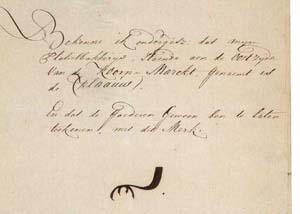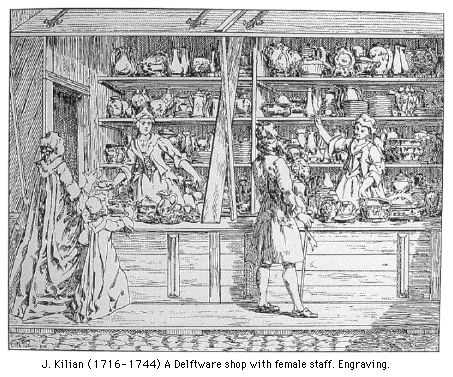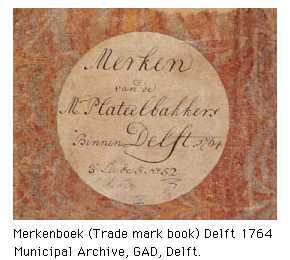 (Porseleine)
Klaauw
(Porseleine)
Klaauw (Porseleine)
Klaauw
(Porseleine)
Klaauw16. De Klaauw aka De Porceleyne Klaauw / de Porseleine Klauw- Porcelain Claw / A la Griffe (workshop active from 1661 to 1811 or 1840), at Gasthuissteeg 9-13. near Koornmarkt, east side, immediately south-east of of the Oude Gasthuis church. At the very end of this main building, just across the Gasthuissteeg alley, there was a cluster of small houses (Gasthuissteeg 9, 11, 13) which had their back to two houses at Lange Breedstraat / Breedstraat nrs 18 and 20. The workshop thus occupied one large building and five small ones.
A wonderful 98 page publication by Hoekstra-Klein focuses on this workshop.
When this workshop was sold in 1740 the owner must have been wealthy as the description mentions a room in which walls were covered in Delftware; gold-tooled leather in the side room and dining room. He also owned large painted murals (probably landscapes) on linnen hung in the 'salet' and numerous paintings elsewere in the house, which included three paintings hung over chimneys.
'Names of houses' file mentions it in 1744 as at the corner of Gasthuissteeg, which defines it as Koornmarkt number 8. Literature: Elisabeth Neurdenburg, 'Oude Nederlandse Majolica en tegels; Delftsch aardewerk', Interbook, Schiedam 1978 (photographic reprint of a book first published in 1943), p. 74.
Delftware Connoisseurship
A serious collector of Delftware will attempt to identify and date the object. On Delft blue plates and other Delftware objects such as jugs, a potters mark may give a first indication. One should always treat potters marks with caution. Marks must be considered as just one indication.
Masters & apprentices
All masters and apprentices working at this workshop had to be inscribed in the Delft St Luke Guild Book. In 1877 this book was published in a 120 page text by Obreen. In 2002 this text has been scanned and is now available and fully searcheable on this internet site. See the yellow field on top; first click the heading Delft Artists & Patrons and then click Obreen. The full text is in Dutch. Spelling varies; in order to find masters or apprentices of a faience workshop (plattielbackers, plateelbacker, platielbacker) search for the letters "plat".

Translation from Trade Mark book 1764: "Declare I the undersigned that my faience workshop at the east side of Koornmarkt is named The Klaauw (the Claw) and that the goods are customarily signed with this mark: __ ".

 Full
presentation at http://www.xs4all.nl/~kalden
Email the author at kalden@xs4all.nl
Full
presentation at http://www.xs4all.nl/~kalden
Email the author at kalden@xs4all.nl
All questions about identifying, dating, valuing, buying and selling: please go to www.Aronson.nl.
Notes: Thanks to the Delft Archives Staff for their help and enthusiasm. See Wik Hoekstra-Klein, volume 2 in her series 'Geschiedenis van de Delftse Plateelbakkerijen', on "De Porceleyne Clauw" , co-produced with the 'Projectgroep Delfts Aardewerk', published by Stedelijk Museum Het Prinsenhof, Delft, 1999. A well researched two volume book on Delftware is Marion S. van Aken-Fehmers et al, Delfts Aardewerk, Geschiedenis van een nationaal product, published jointly by Waanders, Zwolle & Gemeentemuseum, Den Haag, 1999 (part 1) and 2001 (part 2).
Mark shown in Jean Justice, 'Dictionaire des marques et monogrammes de la faience de Delft', Gand/Gent 1901.
How did they make Delft blue faience? text in English
Hoe maakte men Delfts blauw plateel? Tekst in het Nederlands.
Visit The Hague municipal Gemeentemuseum site on Delft Blue.
Latest address location information was added from W. Hoekstra-Klein, Geschiedenis van de Delftse Plateelbakkerijen, vols 1 - 11. Published by the Stedelijk Museum 'Het Prinsenhof' Delft.
This page launched January 2002. Last update 25 October 2016.